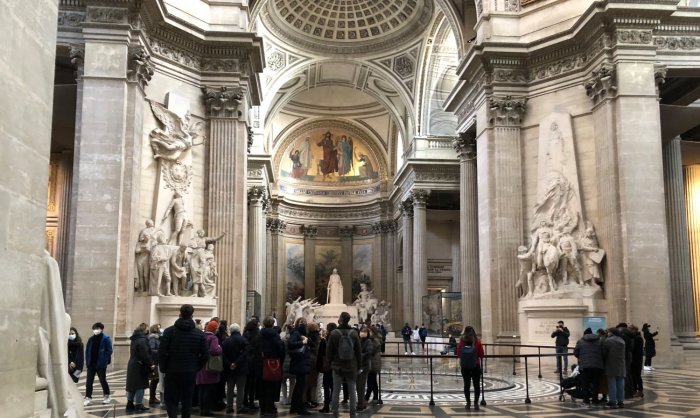Panthéon "To great men the grateful country"

The tallest building in the city, after the Eiffel Tower.
Guided by David Madec, administrator of the Pantheon, we had the chance to discover this imposing neo-classical building which dominates the Sainte-Geneviève Mountain, in the heart of the Latin Quarter. This republican monument was first a church initially built on an abbey which housed the relics of Sainte Geneviève, patroness of Paris.
The Pantheon which was designed by Soufflot is a technical masterpiece, because it mixes several architectural references, including a triple dome and a crypt that covers the entire surface of the building.
During the French Revolution, it was decided that this giant monument would become a secular necropolis for the great French men whose memory France wanted to honor.
It is the President of the Republic who decides which men (and women) will enter the Pantheon, with the agreement of their family.
Mirabeau was the first to enter the building in 1791. He was followed by Voltaire, then Jean-Jacques Rousseau. Many other famous men (and a few women) including Victor Hugo, Louis Braille, Émile Zola, Jean Jaurès, Jean Moulin, Jean Monnet, Pierre and Marie Curie, André Malraux as well as Alexandre Dumas. Simone Veil, accompanied by her husband, was buried there in 2018. The most recent entries were Maurice Genevoix in 2020 and Joséphine Baker in 2021. Only 82 places are being occupied, out of 300.
We had the privilege of going up to the dome, where the view of Paris is breathtaking.
Under the vault, we could admire the pendulum of Léon Foucault (French physicist) (link) with a 28 kg brass sphere suspended by a steel wire measuring 67 m. The pivoting of the pendulum is created by the rotation of the Earth around its own axis. It demonstrates that the Earth rotates on itself, without looking at the stars!
By Armelle de Coudenhove
La Panthéon à Paris (inside) © Bienvenue en France AdeC


